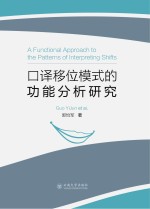

口译移位模式的功能分析研究PDF电子书下载
- 电子书积分:15 积分如何计算积分?
- 作 者:郭怡军著
- 出 版 社:昆明:云南大学出版社
- 出版年份:2017
- ISBN:9787548229599
- 页数:492 页
Chapter 1 INTRODUCTION 1
1.1 Introduction 1
1.2 Research Background 1
1.2.1 Consecutive Interpreting 1
1.2.2 Interpreting Shifts as Translation Shifts 3
1.2.3 Interpreting Shifts in Political Consecutive Interpreting:A SFL Approach 6
1.3 Scope,Aim and Questions of This Study 8
1.4 Research Object,Research Method and Theoretical Framework 9
1.5 Significance 12
1.6 Organization of the Book 14
Chapter 2 CHINA'S HIGH-LEVEL POLITICAL INTERPRETING 15
2.1 Introduction 15
2.2 Genre and Schematic Structure 15
2.3 Institutionalization of China's High-Level Political Interpreting 16
2.4 Institutional Procedures of High-Level Political Interpreting and the Formulation of Its Content 20
2.5 Institutional Requirements for High-Level Political Interpreters and Their Interpreting 25
2.6 Institutionalization of High-Level Political Interpreters'Training 31
2.7 Conclusion 35
Chapter 3 OVERVIEW OF CONFERENCE INTERPRETING STUDIES(Ⅰ):SIMULTANEOUS INTERPREING STUIDES 36
3.1 Introduction 36
3.2 Basic Notions and Categorizations in Interpreting 37
3.2.1 Defining Interpreting 37
3.2.2 Interpreting Modes 38
3.2.3 Interpreting Settings 39
3.2.4 Interpreting Directionality 43
3.2.5 Interpreting Language Modality 45
3.3 Overview of Conference Interpreting Studies 46
3.3.1 A Brief of Conference Interpreting Studies 46
3.3.2 Developmentstages of Conference Interpreting Studies 47
3.2.3 Factors that Led to the Growth of Conference Interpreting Studies 50
3.4 Review of Simultaneous Interpreting Studies 51
3.4.1 Cognitive Issues 52
3.4.2 Bilingualism 52
3.4.3 Linguistic Dominance vs Linguistic Balance 52
3.4.4 Attention 53
3.4.5 Comprehension 54
3.4.6 Memory 57
3.4.7 Processing Models 60
3.4.8 Error Analysis 62
3.4.9 Interpreting Strategies 63
3.4.10 Language Issues 69
3.4.11 Professional Issues 73
3.4.12 Quality Issues 79
3.4.13 Training Issues 89
3.5 Summary 104
Chapter 4 OVERVIEW OF CONFERENCE INTERPRETING STUDIES(Ⅱ):CONFERNECE CONSECUTIVE INTERPREING STUDIES 105
4.1 Introduction 105
4.2 History of Consecutive Interpreting and Its Status in Conference Interpreting 105
4.3 Review of Consecutive Interpreting Studies 107
4.3.1 Attention 107
4.3.2 Memory and Note-Taking 107
4.3.3 Language issues 111
4.3.4 Strategies 119
4.3.5 Process Models 121
4.3.6 Quality Issues 125
4.3.7 Role Issues 126
4.3.8 Contrastive Studies 133
4.3.9 Interdisciplinary Approach to Consecutive Interpreting 134
4.3.10 Training Issues 142
4.4 Summary 153
Chapter 5 THE ORETICAL FRAMEWORK AND RESEARCH METHODOLOGY 154
5.1 Introduction 154
5.2 Descriptive Translation Studies 154
5.3 Systemic Functional Linguistics(SFL) 156
5.4 Research Design 159
5.4.1 Procedures for Collecting Data 160
5.4.2 Methods for Data Analysis 164
Chapter 6 OVERVIEW OF SYSTEMIC FUNCTIONAL LINGUISTICS 169
6.1 Introduction 169
6.2 Functional Grammar and Text Analysis 169
6.3 Context and Text 170
6.4 Experiential Meaning and Lexicogrammar 171
6.4.1 Processes and Participants 172
6.4.2 Circumstance 177
6.5 Interpersonal Meaning and Lexicogrammar 185
6.5.1 Mood System 187
6.5.2 Pronominal Systemn 189
6.5.3 Modality System 191
6.5.4 Interpersonal“lubricants” 198
6.6 Cohesion as Textual Meaning 198
6.6.1 Reference 199
6.6.2 Substitution and Ellipsis 203
6.6.3 Conjunction 204
6.6.4 Lexical Cohesion 205
6.7 Logical Meaning 206
6.8 Summary 208
Chapter 7 SHIFT PATTERNS OF EXPERIENTIAL MEANING 209
7.1 Introduction 209
7.2 Shift Patterns of Experiential Meaning at the Macro-Level and Possible Motivations 209
7.2.1 Omission of Experiential Meaning 209
7.2.2 Addition of Experiential Meaning 217
7.2.3 Correction of Experiential Meaning 232
7.2.4 Conversion of Experiential Meaning 239
7.3 Shift Patterns of Experiential Meaning at the Micro-Level and Possible Motivations 251
7.3.1 Material Process to Relational Attributive Process 251
7.3.2 Relational Attributive Process to Material Process 253
7.3.3 Material Process to Existential Process 254
7.3.4 Relational Attributive Process to Verbal Process 255
7.3.5 Relational Attributive Process to Mental Process 255
7.3.6 Verbal Process to Relational Attributive Process 255
7.3.7 Process to Circumstance 256
7.3.8 Adverbial Circumstance to Prepositional Circumstance 257
7.3.9 Adverbial Circumstance to Process 259
7.4 Discussion and Conclusion 260
7.4.1 Shift Patterns of Experiential Meaning at the Macro-Level 260
7.4.2 Shift Patterns of Experiential Meaning at the Micro-Level 263
Chapter 8 SHIFT PATTERNS OF INTERPERSONAL MEANING 266
8.1 Introduction 266
8.2 Shift Patterns of Interpersonal Meaning and Their Possible Motivations 266
8.2.1 Shift Patterns of Questions 266
8.2.2 Shift Patterns of Person 270
8.2.3 Shift Patterns of Modality 278
8.2.4 Shift Patterns of Other Interpersonal Expressions 286
8.3 Discussion and Conclusion 293
Chapter 9 SHIFT PATTERNS OF COHESION AS TEXTUAL MEANING 299
9.1 Introduction 299
9.2 Shift Patterns of Cohesion and Possible Motivations 299
9.2.1 Shift Patterns of Reference 299
9.2.2 Shift Patterns of Substitution 304
9.2.3 Shift Patterns of Ellipsis 306
9.2.4 Shift Patterns of Conjunction 307
9.2.5 Shift Patterns of Lexical Cohesion 313
9.3 Discussion and Conclusion 319
Chapter 10 SHIFT PATTERNS OF LOGICAL MEANING 322
10.1 Introduction 322
10.2 Shift Patterns of Logical Meaning and Possible Motivations 322
10.2.1 Conjunction Addition within Paratactic structure 323
10.2.2 Conjunction Addition within Hypotactic Structure 327
10.3 Discussion and Conclusion 336
Chapter 11 CONCLUSION 339
11.1 The Contributions of the Study 339
11.2 Limitations and Future Research Directions 341
References 343
Appendixes 395
- 《水面舰艇编队作战运筹分析》谭安胜著 2009
- 《红色旅游的社会效应研究》吴春焕著 2019
- 《汉语词汇知识与习得研究》邢红兵主编 2019
- 《生物质甘油共气化制氢基础研究》赵丽霞 2019
- 《东北民歌文化研究及艺术探析》(中国)杨清波 2019
- 《联吡啶基钌光敏染料的结构与性能的理论研究》李明霞 2019
- 《异质性条件下技术创新最优市场结构研究 以中国高技术产业为例》千慧雄 2019
- 《分析化学》陈怀侠主编 2019
- 《《国语》和《战国策》词汇比较研究》陈长书著 2017
- 《中国制造业绿色供应链发展研究报告》中国电子信息产业发展研究院 2019
- 《小岛区块链》方军著 2020
- 《面向可持续发展的马克思主义经济科学研究》刘正刚,李晓,田军著 2018
- 《冷战时代的中国战略决策》牛军著 2019
- 《排放权有偿使用定价》郭默,王金南,毕军著 2019
- 《敖汉“粟 ”源》朱佳,顾军著 2019
- 《民国十大悍将》王晓华,张庆军著 2019
- 《屈原》郭怡汾著 2019
- 《放养,让孩子像孩子那样成长》范晓军著 2019
- 《穿透式学习》方军著 2020
- 《公民健康与社会理论》景军著 2019
- 《大学计算机实验指导及习题解答》曹成志,宋长龙 2019
- 《大学生心理健康与人生发展》王琳责任编辑;(中国)肖宇 2019
- 《大学英语四级考试全真试题 标准模拟 四级》汪开虎主编 2012
- 《大学英语教学的跨文化交际视角研究与创新发展》许丽云,刘枫,尚利明著 2020
- 《复旦大学新闻学院教授学术丛书 新闻实务随想录》刘海贵 2019
- 《大学英语综合教程 1》王佃春,骆敏主编 2015
- 《大学物理简明教程 下 第2版》施卫主编 2020
- 《大学化学实验》李爱勤,侯学会主编 2016
- 《中国生态系统定位观测与研究数据集 森林生态系统卷 云南西双版纳》邓晓保·唐建维 2010
- 《中国十大出版家》王震,贺越明著 1991
